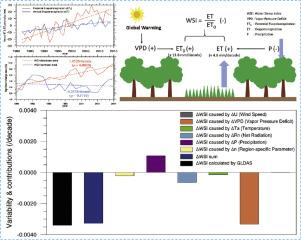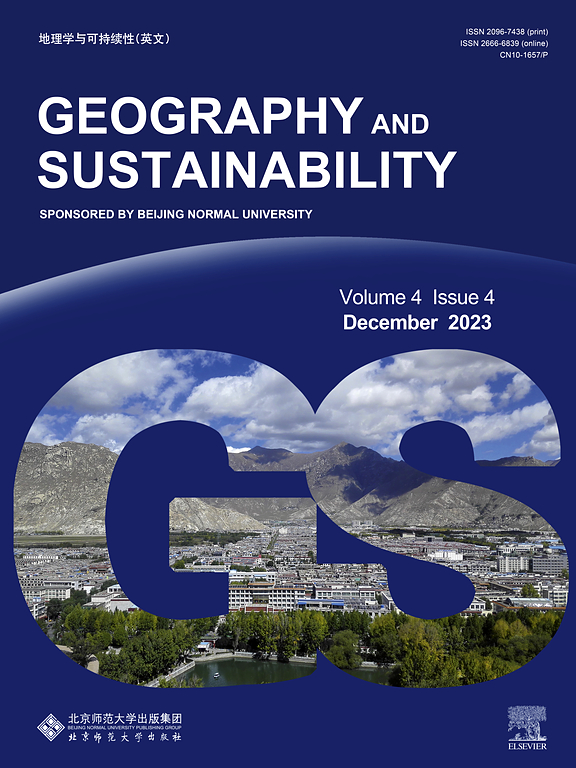Exacerbated global surface water stress under climate change
IF 8
1区 环境科学与生态学
Q1 GEOGRAPHY, PHYSICAL
引用次数: 0
Abstract
Water stress is expected to intensify due to escalating atmospheric and surface dryness under global warming. Despite extensive research indicate that intensified dryness exacerbates water constraints on ecosystems, the dynamics and underlying mechanisms of surface water stress (SWS) under climate change remain poorly understood. In this study, we use annual evaporative stress as the surface water stress index (WSI) and provide a comprehensive analysis of historical and projected global terrestrial SWS, covering its characteristic changes, driving factors, and impacts on vegetation. Our results show a significant declining trend in WSI during 1982–2014 (-0.0033/decade, p < 0.01), indicating the enhancement of SWS concurrent with a rapid expansion of water stress intensified areas at a rate of 1.85 %/decade (p < 0.01). Using the Budyko-Penman budget framework, we found that the intensification of SWS was primarily driven by an increase in vapor pressure deficit (VPD) and a decrease in precipitation. Furthermore, the intensification of SWS contributed to a decline in vegetation growth, with the extent of areas experiencing increased vegetation water deficit expanding rapidly at a rate of 1.38 % per decade (p < 0.01). In the future, SWS is projected to escalate, with the proportion of areas experiencing intensified SWS increasing from 6.3 % to 24.3 % by the end of the century under the SSP5–8.5. Our study provides a comprehensive analysis of the drivers of SWS under climate change and its impacts on ecosystems, offering valuable scientific insights for the effective management of water resources.

气候变化下全球地表水压力加剧
由于全球变暖导致大气和地表日益干燥,预计水资源压力将加剧。尽管广泛的研究表明,干旱加剧加剧了生态系统的水约束,但气候变化下地表水胁迫(SWS)的动态和潜在机制仍然知之甚少。本研究以年蒸发胁迫作为地表水胁迫指数(WSI),对全球陆地SWS的变化特征、驱动因素以及对植被的影响进行了综合分析。结果表明,1982-2014年WSI呈显著下降趋势(-0.0033/ 10年,p < 0.01),表明SWS增强的同时,水分胁迫加剧区域以1.85% / 10年的速度迅速扩大(p < 0.01)。利用buddyko - penman预算框架,我们发现SWS的增强主要是由水汽压亏缺(VPD)的增加和降水的减少驱动的。此外,SWS的加剧导致植被生长下降,植被水分亏缺增加的面积以每10年1.38%的速度迅速扩大(p < 0.01)。在SSP5-8.5下,预计未来SWS将升级,到本世纪末经历SWS强化的地区比例将从6.3%增加到24.3%。本研究全面分析了气候变化下SWS的驱动因素及其对生态系统的影响,为水资源的有效管理提供了有价值的科学见解。
本文章由计算机程序翻译,如有差异,请以英文原文为准。
求助全文
约1分钟内获得全文
求助全文
来源期刊

Geography and Sustainability
Social Sciences-Geography, Planning and Development
CiteScore
16.70
自引率
3.10%
发文量
32
审稿时长
41 days
期刊介绍:
Geography and Sustainability serves as a central hub for interdisciplinary research and education aimed at promoting sustainable development from an integrated geography perspective. By bridging natural and human sciences, the journal fosters broader analysis and innovative thinking on global and regional sustainability issues.
Geography and Sustainability welcomes original, high-quality research articles, review articles, short communications, technical comments, perspective articles and editorials on the following themes:
Geographical Processes: Interactions with and between water, soil, atmosphere and the biosphere and their spatio-temporal variations;
Human-Environmental Systems: Interactions between humans and the environment, resilience of socio-ecological systems and vulnerability;
Ecosystem Services and Human Wellbeing: Ecosystem structure, processes, services and their linkages with human wellbeing;
Sustainable Development: Theory, practice and critical challenges in sustainable development.
 求助内容:
求助内容: 应助结果提醒方式:
应助结果提醒方式:


